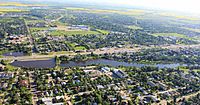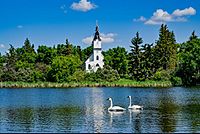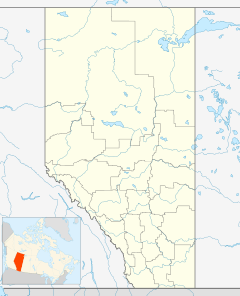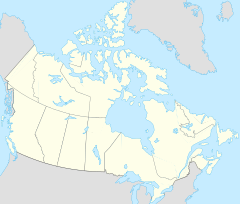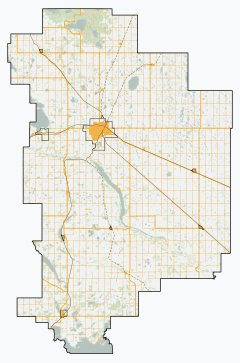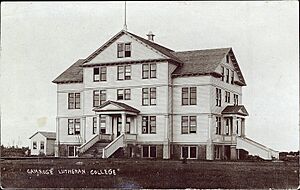Camrose, Alberta facts for kids
Quick facts for kids
Camrose
|
|||
|---|---|---|---|
|
City
|
|||
| City of Camrose | |||
|
|||
| Nicknames:
The Rose City
Slogan: The stage is set |
|||
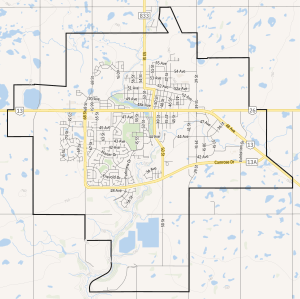
City boundaries
|
|||
| Country | Canada | ||
| Province | Alberta | ||
| Planning region | North Saskatchewan | ||
| Municipal district | Camrose County | ||
| Incorporated | |||
| • Village | May 4, 1905 | ||
| • Town | December 11, 1906 | ||
| • City | January 1, 1955 | ||
| Area
(2021)
|
|||
| • Land | 41.67 km2 (16.09 sq mi) | ||
| Elevation | 740 m (2,430 ft) | ||
| Population
(2021)
|
|||
| • Total | 18,772 | ||
| • Density | 450.5/km2 (1,167/sq mi) | ||
| • Municipal census (2016) | 18,044 | ||
| • Estimate (2020) | 19,333 | ||
| Time zone | UTC−7 (Mountain) | ||
| • Summer (DST) | UTC−6 (MDT) | ||
| Forward sortation area |
T4V
|
||
| Area code(s) | 780, 587, 825, 368 | ||
| NTS Map | 83H2 Camrose | ||
| GNBC Code | IAKKF | ||
| Highways | 13, 26, 833 | ||
Camrose is a city in central Alberta, Canada. It is surrounded by Camrose County. The city is located along Highway 13. Camrose started as an important railway center.
Contents
History of Camrose
The area around Camrose was first settled by Europeans around the year 1900. Back then, Wetaskiwin was a big stop for pioneers. It was often their last stop before they looked for land nearby. The future site of Camrose was about a day's journey from Wetaskiwin by train. This made it a popular spot for pioneers to rest.
Soon, business people and other settlers decided to stay. Many settlers came from Scandinavian countries like Norway and Sweden. Others came from the United States. At first, the settlement was called Stoney Creek. In 1904, Stoney Creek got mail service and its first businesses opened. Its first Royal Canadian Mounted Police (RCMP) officer also arrived.
On May 4, 1905, the community became the Village of Camrose. No one knows for sure why the name Camrose was chosen. Most people think it was named after a village called Camrose in South Wales. On December 11, 1906, Camrose officially became a town.
In 1906, Camrose started its first newspaper, The Camrose Mail. This was replaced in 1908 by the Camrose Canadian, which was printed until 2018. In March 1907, the town built a new building for its government. It also held the first police and fire station. In May 1907, the town spent $10,000 on its schoolhouse.
In October 1907, workers set up Camrose's first telephone system. By 1908, about 50 homes had phone access. In 1911, Camrose built its first power plant.
From 1905 to 1914, many railways were built near Camrose. Camrose became a busy railway hub. Trains connected it to big cities like Edmonton and Calgary. It also connected to smaller towns in central Alberta. By 1914, twelve passenger trains passed through Camrose every day. The growth of Camrose was strongly linked to the railway.
On June 26, 1912, the first building of the Camrose Lutheran College opened. Today, this campus is part of the University of Alberta. It is known as the Augustana Faculty.
During World War II, the Camrose Fairgrounds became an army training camp. Many huts and other buildings were built. Thousands of young Canadian men came to Camrose for their basic training.
Camrose became a city on January 1, 1955. By 1958, the old post office became the new city hall. Before that, the city council met in a church hall for almost three years.
Camrose has continued to grow, even as railways became less important. It is now expanding along Highway 13. It has become a major stop for travelers. With the Big Valley Jamboree music festival, Camrose is also a popular place for tourism.
Camrose used to host a music camp called MusiCamrose for over 40 years. It later moved to Red Deer. In October 2005, a lottery ticket worth $54 million was sold in Camrose. This was one of the largest lottery wins in Canadian history. In August 2006, Camrose celebrated its Founders Day. Four men were honored as the founding fathers of the city.
Camrose Geography and Climate
Camrose is about 90 kilometers (56 miles) from Edmonton, Alberta's capital city. Highway 13 runs right through the middle of Camrose. The city is located in a special area of Alberta. This area is between the prairie grasslands and the boreal forest. It is known as aspen parkland. Camrose is an important business center for many small farming communities nearby. The Stoney Creek runs through the city. It flows into the Battle River south of Camrose.
Camrose Weather
Camrose has a climate with warm summers and cold winters. It is known as a humid continental climate. Summers have moderate rainfall. Winters can be long and very cold.
| Climate data for Camrose (1981−2010 normals) | |||||||||||||
|---|---|---|---|---|---|---|---|---|---|---|---|---|---|
| Month | Jan | Feb | Mar | Apr | May | Jun | Jul | Aug | Sep | Oct | Nov | Dec | Year |
| Record high humidex | 11.0 | 11.6 | 24.5 | 25.4 | 31.6 | 37.2 | 39.7 | 38.5 | 33.3 | 26.6 | 17.3 | 13.4 | 39.7 |
| Record high °C (°F) | 11.1 (52.0) |
13.5 (56.3) |
25.1 (77.2) |
31.1 (88.0) |
32.5 (90.5) |
34.2 (93.6) |
36.7 (98.1) |
34.4 (93.9) |
33.0 (91.4) |
28.0 (82.4) |
21.1 (70.0) |
13.9 (57.0) |
36.7 (98.1) |
| Mean daily maximum °C (°F) | −5.8 (21.6) |
−3.5 (25.7) |
1.5 (34.7) |
10.7 (51.3) |
17.0 (62.6) |
20.4 (68.7) |
22.9 (73.2) |
22.3 (72.1) |
16.7 (62.1) |
10.2 (50.4) |
−0.3 (31.5) |
−4.5 (23.9) |
9.0 (48.2) |
| Daily mean °C (°F) | −11.5 (11.3) |
−9.6 (14.7) |
−4.1 (24.6) |
4.5 (40.1) |
10.5 (50.9) |
14.5 (58.1) |
16.8 (62.2) |
15.8 (60.4) |
10.4 (50.7) |
4.1 (39.4) |
−5.2 (22.6) |
−9.9 (14.2) |
3.0 (37.4) |
| Mean daily minimum °C (°F) | −17.2 (1.0) |
−15.7 (3.7) |
−9.7 (14.5) |
−1.7 (28.9) |
4.0 (39.2) |
8.5 (47.3) |
10.7 (51.3) |
9.3 (48.7) |
4.0 (39.2) |
−2.0 (28.4) |
−10.0 (14.0) |
−15.3 (4.5) |
−2.9 (26.8) |
| Record low °C (°F) | −47.2 (−53.0) |
−47.8 (−54.0) |
−42.8 (−45.0) |
−32.2 (−26.0) |
−11.7 (10.9) |
−1.1 (30.0) |
1.0 (33.8) |
−1.1 (30.0) |
−16.1 (3.0) |
−23.0 (−9.4) |
−35.7 (−32.3) |
−44.0 (−47.2) |
−47.8 (−54.0) |
| Record low wind chill | −54.0 | −52.0 | −47.0 | −29.0 | −15.0 | −3.0 | 0.0 | 0.0 | −12.0 | −26.0 | −44.0 | −50.0 | −54.0 |
| Average precipitation mm (inches) | 22.8 (0.90) |
13.5 (0.53) |
22.5 (0.89) |
28.9 (1.14) |
41.2 (1.62) |
74.4 (2.93) |
85.8 (3.38) |
51.5 (2.03) |
39.9 (1.57) |
23.5 (0.93) |
18.5 (0.73) |
15.4 (0.61) |
438.1 (17.25) |
| Average rainfall mm (inches) | 0.8 (0.03) |
0.3 (0.01) |
1.4 (0.06) |
18.4 (0.72) |
38.0 (1.50) |
74.4 (2.93) |
85.8 (3.38) |
51.5 (2.03) |
39.6 (1.56) |
13.2 (0.52) |
2.0 (0.08) |
0.9 (0.04) |
326.3 (12.85) |
| Average snowfall cm (inches) | 21.6 (8.5) |
13.4 (5.3) |
21.7 (8.5) |
10.5 (4.1) |
3.2 (1.3) |
0.0 (0.0) |
0.0 (0.0) |
0.0 (0.0) |
0.2 (0.1) |
10.5 (4.1) |
16.8 (6.6) |
15.6 (6.1) |
113.5 (44.7) |
| Source: Environment Canada | |||||||||||||
People and Culture in Camrose
|
|||||||||||||||||||||||||||||||||||||||||||||||||||||||||||||||||||||||||||||||||
In the 2021 Census, the City of Camrose had a population of 18,772 people. This was a small increase from its 2016 population of 18,742. Camrose covers an area of 41.67 square kilometers.
Ancestry and Languages
Many people in Camrose have roots from different parts of the world. The main ancestries are Scandinavian (from countries like Norway and Sweden), German, English, Scottish, and Irish. About 3.5% of residents have Aboriginal ancestry.
Most people in Camrose speak English as their first language (90%). Other languages spoken include German, Ukrainian, French, and Spanish.
Religious Beliefs
In 2001, about 85% of Camrose residents identified as Christian. About 14% said they had no religious connection. Among Christians, many identified as Roman Catholic, Lutheran, or with the United Church of Canada.
Sports and Fun in Camrose
The Camrose Recreation Centre is a big sports facility. It opened in 2007. It includes the 2,500-seat Encana Arena. This is home to the Camrose Kodiaks hockey team and the Augustana Vikings. The center also has a fitness track, gym, and meeting rooms. The Max McLean Arena, Camrose Aquatic Centre, and curling rink are also connected.
Other fun places include the Camrose Community Centre. This has a walking track and indoor soccer. There is also a spray park and a skate park. Kinsmen Park has tennis courts, baseball fields, and beach volleyball. Rudy Swanson Park has soccer fields.
Camrose has a large system of walking trails. These trails wind through the Stoney Creek Valley. The total length of the trails is about 10.2 kilometers (6.3 miles).
Camrose is home to many sports clubs. These include figure skating, baseball, football, hockey, and swimming. The Camrose Ski Club started in 1911. It is the oldest cross-country ski club in Canada. Many top athletes, including Olympians, have come from this club.
City Parks and Green Spaces
Camrose is often called the "Rose City." This is because many wild roses grow in the parks around it. The special Camrose Rose was created to grow well in Alberta's climate. You can see this rose at the Bill Fowler Centre.
- Jubilee Park is a popular park in a valley. It has barbecue areas, a stream, and open spaces.
- Mirror Lake is in the center of the city. It was once a water source for power plants. Later, it was home to two types of swans. The city cared for these swans for over 20 years. In 2019, the city council decided to end the swan program. This was mainly due to concerns about keeping wild animals confined.
- Mirror Lake Park is a main part of Camrose's park system. It is next to Mirror Lake. The Bill Fowler Centre is here. It has a nature mural carved from red brick. The mural shows many animals found near Mirror Lake.
- Stoney Creek flows into Mirror Lake. It winds through the city. It offers a beautiful valley for seeing wildlife. There are paved walking paths along the creek.
City Services and Education
Camrose has its own airport, the Camrose Airport. The city gets its water from nearby Driedmeat Lake.
Schools in Camrose
Three main groups provide schooling in Camrose. These are the Battle River School Division (BRSD), Conseil Scolaire Centre-Nord (CSCN), and Elk Island Catholic Schools (EICS). The BRSD runs many schools in and around Camrose. EICS has one elementary school and one junior/senior high school. CSCN operates one school.
Colleges and Universities
The main college in Camrose is the Augustana Faculty of the University of Alberta. It was started in 1910 by Norwegian settlers. It was first called Camrose Lutheran College. In 2006, the university celebrated its first fourth-generation graduate. This means someone from the same family had graduated from the college for four generations.
Camrose also has the Canadian Lutheran Bible Institute. It used to be home to Gardner College as well.
Media and News
Camrose has local newspapers and radio stations. The weekly Camrose Canadian used to be published until 2018. Now, the weekly Camrose Booster and the small daily Camrose Morning News serve the city. There is also a monthly Christian paper called "Crosswalk."
Camrose is home to two radio stations. One is AM station 840 CFCW. The other is FM station New Country 98.1. Both stations are owned by Stingray Radio.
Camrose Sister Cities
Camrose has special "twinning agreements" with several cities. These are in Canada and around the world. These partnerships help promote friendship, learning, and tourism.
- Kamifurano, Hokkaido, Japan – since 1984
- Warwick, Queensland, Australia – since 1974
- Saguenay, Quebec, Canada (formerly Chicoutimi) – since 1978
- Kentville, Nova Scotia, Canada – since 1980
Famous People from Camrose
- Tyler Bouck, retired professional hockey player
- Brennan Evans, former professional hockey player
- Scott Ferguson, retired professional hockey player
- Josh Green, retired professional hockey player
- Deena Hinshaw, health officer
- Kenneth E. Iverson, computer scientist
- Parker Kelly, professional hockey player
- Justin Kirkland, professional hockey player
- Karl Stollery, professional hockey player
- Verlyn Olson, former politician
See also
 In Spanish: Camrose para niños
In Spanish: Camrose para niños


